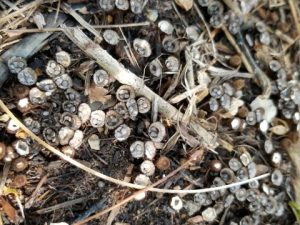
One of the great things about writing this blog is that many of you send me your unusual findings, too. Sometimes I’ll recognize it right away, but others are completely new to me. Those mysterious organisms are the ones that I always find most interesting, appealing to my innate curiosity about the natural world.
Last week, a reader sent me an unusual photo of several dozen small cup-like structures she found under the mulch in her backyard. At first glance they looked like opened lizard eggs, but they also seemed plantlike or shaped like a bird’s nest. Inside each nest were 5-8 “seeds,” with near-radial symmetry like a flower.

This one stumped me, but the great thing about working with fellow Extension agents is that all of us are full of random information on our fields of expertise. I asked our plant experts in the office, and our horticulture agent Beth recognized it as neither plant nor animal, but a bird’s nest fungi. The ones typical in our area are members of the genera Cyathus and Crucibulum.
According to the UF Department of Entomology and Nematology, this native fungus is very common in landscape mulch and nursery growth media. Like more recognizable fungi, including mushrooms, it is considered “saprophytic,” meaning it feeds off dead and dying organic material. The fungi reproduce sexually in a cup-shaped structure that resembles a bird’s nest, producing multiple “eggs” inside. These eggs are called peridioles and contain spores. The peridiole/eggs can be ejected several feet out of the nest by rainwater or air pressure onto an adjacent plant or leaf. The peridioles look like scale insects and may be misidentified as such. Once it dries out, the spores are released and new fungus begins to grow.
The fungi are not typically problematic and fungicides are not recommended. If the spores stick to unwanted surfaces or a large number of them appear, they can be raked and removed. If you are truly interested in learning more about this interesting fungus, an entire book, “The Bird’s Nest Fungi,” has been written on them by H.J. Brodie in 1977, and it can still be found online.
 1
1
